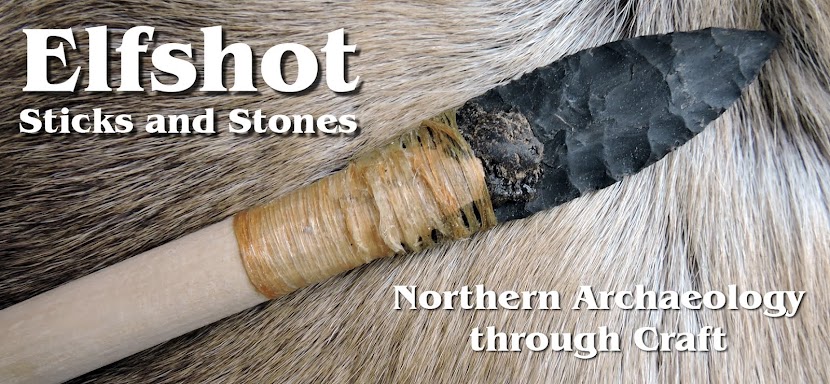Photo Credit: From the Newfoundland and Labrador Archaeological Society Facebook Page.
Friday, May 29, 2015
Wednesday, May 27, 2015
Splitting Birch and Knapping Glass
 |
| Splitting the birch |
 |
| Fibre Optic Glass |
 |
| I need at least three darts. I'm hoping that I can find them somwhere in these five staves. |
Photo Credits: Tim Rast
Monday, May 25, 2015
Groswater Palaeoeskimo Harpoon with Spare Parts
 |
| Groswater Palaeoeskimo Harpoon Heads |
 |
| All three harpoon heads fit the same whale bone foreshaft. |
 |
| The selfbladed antler harpoon head is designed to toggle, but it also has a single barb to help secure it in the prey. |
 |
| I used softwood for the main body of the harpoon and sealskin for the lines and lashing |
 |
| A Newfoundland chert endblade lashed to an antler harpoon head with sinew. The foreshaft is whalebone and the braided line threaded through the harpoon head line hole is sinew. |
 |
| I suspect Groswater hunters maintained similar spare harpoon heads for inevitably lost or damaged parts or different prey or hunting conditions. |
Photo Credits: Tim Rast
Labels:
Groswater,
Harpoon,
Harpoon Heads,
Portfolio,
Reproductions
Friday, May 22, 2015
Northern Plains Projectile Points
 |
| Record in Stone and reproductions |
I don't want all the points in a set like this to look like they were made by one person at one time. If very different tools or techniques were used to make the original artifacts, I'll try to mimic those as best that I can. I also made each projectile point from a different type of stone to try to build variety into the set.
 |
| The complete set of reproductions arranged in chronological order from top to bottom |
 |
| Spot the reproduction... |
Labels:
Arrowheads,
Flintknapping,
Portfolio,
Reproductions
Wednesday, May 20, 2015
Groswater harpoon progress
 |
| Un-notched Groswater Endblade |
 |
| Stretching and drying sealskin for the harpoon line and lashings. |
Monday, May 18, 2015
Ptarmigan Feathers
Friday, May 15, 2015
Start of the long weekend
Wednesday, May 13, 2015
Bilboquets
The bilboquets or pin-and-cup games I showed boiling on Monday are dried and ready to ship now. I discussed it with the client and given the way these toys are intended to be used, we decided to go with braided artificial sinew instead of real sinew. It looks the same, but it should last a little longer, with less maintenance than real sinew. The bone targets, pins, and cords range in size and therefore difficulty. The pins are primarily ribs and the targets are cut from caribou long bones and whale ribs.
Photo Credits: Tim Rast
 |
| Set of nine bilboquets |
 |
| The different sizes and hole diameters make some of the toys more challenging than others. |
Monday, May 11, 2015
You want what?
 |
| Bone pin and cup games, minus the sinew string that will connect the two parts together. |
 |
| Boiling out the grease and marrow |
Friday, May 8, 2015
Northern Archaic Reproductions made from Alaskan Obsidian
 |
| Obsidian dart point and reference drawing |
 |
| A flintknapping reduction sequence from a hard hammer flake (left) to a soft hammered biface (middle) to a projectile point finished with pressure flaking. |
Wednesday, May 6, 2015
Spring Cleaning
Monday, May 4, 2015
Emulating Independence I Tool Makers
 The current issue of Above&Beyond, Canada's Arctic Journal contains an article that I wrote about the Quttinirpaaq National Park reproductions that I made a couple years back. If you've ever visited the Canadian Arctic, you might recognize Above&Beyond as the inflight magazine of First Air. Here is a link to the full issue and my article called "Emulating Independence I Tool Makers: Quttinirpaaq National Park's Oldest Artifacts".
The current issue of Above&Beyond, Canada's Arctic Journal contains an article that I wrote about the Quttinirpaaq National Park reproductions that I made a couple years back. If you've ever visited the Canadian Arctic, you might recognize Above&Beyond as the inflight magazine of First Air. Here is a link to the full issue and my article called "Emulating Independence I Tool Makers: Quttinirpaaq National Park's Oldest Artifacts". |
| Link to story |
Photo Credits: Screen Captures from Above&Beyond
Friday, May 1, 2015
Chocolate harpoon heads
Subscribe to:
Posts (Atom)







